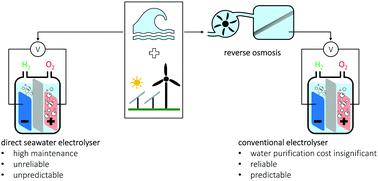当前位置:
X-MOL 学术
›
Energy Environ. Sci.
›
论文详情
Our official English website, www.x-mol.net, welcomes your feedback! (Note: you will need to create a separate account there.)
Is direct seawater splitting economically meaningful?
Energy & Environmental Science ( IF 32.5 ) Pub Date : 2021-6-9 , DOI: 10.1039/d0ee03659e J. Niklas Hausmann 1, 2, 3, 4, 5 , Robert Schlögl 5, 6, 7, 8, 9 , Prashanth W. Menezes 1, 2, 3, 4, 5 , Matthias Driess 1, 2, 3, 4, 5
Energy & Environmental Science ( IF 32.5 ) Pub Date : 2021-6-9 , DOI: 10.1039/d0ee03659e J. Niklas Hausmann 1, 2, 3, 4, 5 , Robert Schlögl 5, 6, 7, 8, 9 , Prashanth W. Menezes 1, 2, 3, 4, 5 , Matthias Driess 1, 2, 3, 4, 5
Affiliation

|
Electrocatalytic water splitting is the key process for the formation of green fuels for energy transport and storage in a sustainable energy economy. Besides electricity, it requires water, an aspect that seldomly has been considered until recently. As freshwater is a limited resource (<1% of earth's water), lately, plentiful reports were published on direct seawater (around 96.5% of earth's water) splitting without or with additives (buffers or bases). Alternatively, the seawater can be split in two steps, where it is first purified by reverse osmosis and then split in a conventional water electrolyser. This quantitative analysis discusses the challenges of the direct usage of non-purified seawater. Further, herein, we compare the energy requirements and costs of seawater purification with those of conventional water splitting. We find that direct seawater splitting has substantial drawbacks compared to conventional water splitting and bears almost no advantage. In short, it is less promising than the two-step scenario, as the capital and operating costs of water purification are insignificant compared to those of electrolysis of pure water.
中文翻译:

直接海水分解在经济上有意义吗?
电催化水分解是在可持续能源经济中形成用于能源运输和储存的绿色燃料的关键过程。除了电,它还需要水,直到最近才很少考虑这一方面。由于淡水是一种有限的资源(不到地球水的 1%),最近发表了大量关于直接海水(约占地球水的 96.5%)在没有或有添加剂(缓冲剂或碱)的情况下分裂的报告。或者,海水可以分两步分解,首先通过反渗透进行净化,然后在传统的水电解槽中分解。该定量分析讨论了直接使用未净化海水的挑战。此外,在此,我们将海水净化的能源需求和成本与传统水分解的能源需求和成本进行了比较。我们发现,与传统的水分解相比,直接海水分解有很大的缺点,几乎没有优势。简而言之,它不如两步方案有希望,因为与纯水电解相比,水净化的资本和运营成本微不足道。
更新日期:2021-06-16
中文翻译:

直接海水分解在经济上有意义吗?
电催化水分解是在可持续能源经济中形成用于能源运输和储存的绿色燃料的关键过程。除了电,它还需要水,直到最近才很少考虑这一方面。由于淡水是一种有限的资源(不到地球水的 1%),最近发表了大量关于直接海水(约占地球水的 96.5%)在没有或有添加剂(缓冲剂或碱)的情况下分裂的报告。或者,海水可以分两步分解,首先通过反渗透进行净化,然后在传统的水电解槽中分解。该定量分析讨论了直接使用未净化海水的挑战。此外,在此,我们将海水净化的能源需求和成本与传统水分解的能源需求和成本进行了比较。我们发现,与传统的水分解相比,直接海水分解有很大的缺点,几乎没有优势。简而言之,它不如两步方案有希望,因为与纯水电解相比,水净化的资本和运营成本微不足道。


























 京公网安备 11010802027423号
京公网安备 11010802027423号